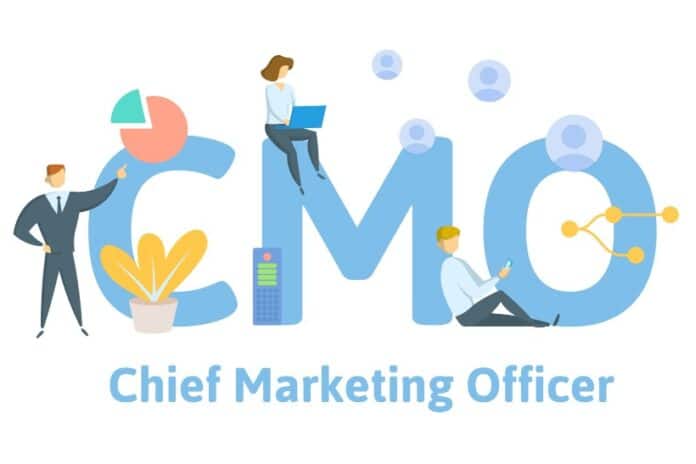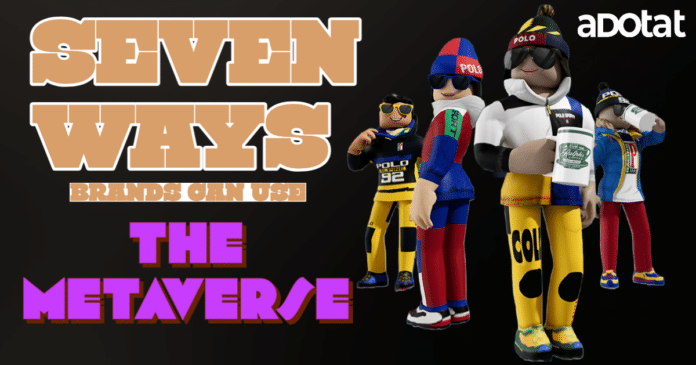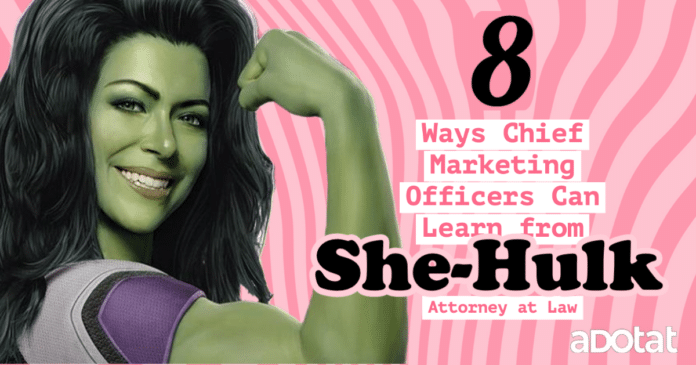I’ve always been a fan of She-Hulk. As one of the few superheroes who is also a lawyer, she’s an inspiration for many women in law and business. Many chief marketing officers (CMOs) could learn from her example with just a few simple adjustments.
Here are my top ten lessons from She-Hulk: Attorney At Law:
Make Sure You Have the Right Team.
I’m pretty sure you’ve heard this one before, but it’s worth repeating: You need the right team. As strong as the She-Hulk is, she often needed help and emotional support. And while it’s true that Hulks are known for their strength (and they do have a bit of an attitude problem) they also happen to be great listeners—which is another reason why they make good leaders. They can listen to others’ concerns and then weigh in with their own thoughts on how everyone should proceed together.
To get started finding your team, try out one of these tips:
1. Delegate your authority and trust them to get the job done. If you don’t think they can do it, why are you hiring them?
2. Work with your team instead of against them. You need to be able to communicate clearly and honestly with each other in order to get the most out of each other’s talents and skills.
3. Be a team player. You’re not always going to agree with each other, but it’s important that you respect one another and are willing to compromise. Even if you’re the “boss.”
4. Hire the right people for the job. This is often easier said than done, but make sure you’re hiring people who are qualified and passionate about what they do.
5. Set clear goals and expectations for your team. If everyone knows what’s expected of them, it’s easier to get things done quickly and efficiently!
6. Be a good teammate yourself by stepping up when needed or taking one for the team if necessary
Know When to Take Action.
One of the most important things CMOs can do is know when to take action. Unlike She-Hulk, however, who lives in a world where she can be as loud and bold as she wants and no one will judge her for it (nor will they even notice), you have to face the fact that there are people who care about what you do. They have expectations for how you should act and treat them accordingly.
The problem is that many CMOs are too cautious when it comes time to make decisions or take steps forward in their marketing efforts. They’ll never get anywhere if they’re afraid of making mistakes—the most successful leaders in any field realize that failure isn’t really failure; it’s an opportunity for growth and development. And while we’re all human beings who make mistakes from time to time (including me), this doesn’t mean we should let fear hold us back from taking calculated risks when necessary!
As a CMO, you need to be willing to take risks and try new things—even if they don’t work out. It’s not always easy, but it’s necessary if you want your marketing efforts to be successful. Ask yourself: Why do people follow leaders? Because they believe in them and trust that those leaders will make good decisions for the business. If you’re not making mistakes and learning from them along the way, how can anyone know that you’re worthy of following?
Aways Keeps the Client Satisfied.
She-Hulk is like a client’s best friend. She’s always keeping them up to date on the progress of their case, and she doesn’t let them get left in the dark. When she’s working on a case, she never misses a deadline and always delivers high-quality work. A client can trust that She-Hulk will meet their expectations, even if they don’t know exactly what those are.
If you have customers, you have complaints.
It’s a fact. However good your products are, there will inevitably be some negative feedback from them. And it’s not about avoiding complaints—it’s about dealing with them swiftly and effectively when they arise.
When your team becomes aware of a problem, contact the customer directly to find out what went wrong and do your best to make it right. This keeps clients happy and allows you to turn potential problems into opportunities.
If you want to be successful, you need to be able to anticipate your clients’ needs. This can be difficult if you’re a small business that focuses on a niche market. But it’s worth it—the more specific your products are, the easier they are for consumers to identify with and relate to. It might help to have telepathy, but we don’t so make sure to communicate!
Have a Strategy, Not Just Tactics.
I know what you’re thinking: “But Tina, I already have a strategy! We have all the latest and greatest analytics tools, and our marketing team has spent years developing an intricate funnel analysis that will drive us to market domination. We’re in the business of strategy! Where else would we be?” Also, you might be wondering who Tina is?
OK then.
Let’s talk about She-Hulk vs The Hulk: Attorney at Law by Charles Soule and Javier Pulido from Marvel Comics. You see, this is a comic book where She-Hulk defeats The Hulk in court —and she does it using nothing more than her wit and intelligence along with some help from her friends (who are also superhero lawyers).
However, she doesn’t beat The Hulk because she has better data or a more advanced technical platform.
She wins because she’s smarter than him.
This is a lesson that many marketers need to learn: We don’t win by being better at tactics (like sending out lots of emails or creating social media content), but rather by being smart about how we use them.
The first thing we need to do is understand what it means to be smart.
It’s not just about having good ideas or being creative (although those things are important). Rather, it’s about understanding how your target audience thinks and why they act the way they do—a skill I call “conceptual intelligence.”
A lot of marketers are smart in the technical sense, but not conceptual. They know how to send emails and create Facebook ads, but they can’t explain why these things work or what makes them effective.
If you don’t have a basic understanding of human psychology (and I mean an actual understanding), then you won’t be able to create content that resonates with your target audience.
She Hulk is Aways Aware of the Competition.
She-Hulk is always aware of what the competition is doing, especially if its Titania. She has a team at her disposal, and if one of her associates notices an opening in the market for She Hulk to add on a new client or company, she’ll put herself in that position immediately.
This can be an invaluable tool for marketing executives: you should know what your competitors are up to so that you can stay ahead of them.
Think about it this way: She-Hulk’s greatest strength isn’t her ability to punch people through walls, but rather her ability to anticipate and react to the competition.
When Titania comes after you with all guns blazing (and she will), take note of how she comes at things—and then use that knowledge against her later on when necessary!
What do you do if your competition is far more powerful than you? In a one-on-one battle, She-Hulk would be hard pressed to defeat Titania. But that doesn’t mean she’s out of luck—not by a long shot! She has the ability to anticipate what her rival will do next and use that knowledge against her.
If Titania is going to throw an object at her head, She Hulk can simply step out of the way and let it fly past harmlessly. What am I saying?
Market Research and Competitive Research always helps. Don’t get the metaphor? Tough, we worked all night on it.
Know Your Super Powers.
She-Hulk is a lawyer, but she also has superpowers. She can turn into a giant green monster when she gets angry. That’s not a superpower that every lawyer has, but it does give her an advantage in court: If your opponent upsets you during the trial, you can just smash them through the wall and then claim “self-defense.”
Your marketing team might not have any powers like Hulk’s (or even one), but we bet they all have their own unique strengths and weaknesses. When it comes time to build your marketing strategy, think about what each person on your team brings to the table—and make sure that whoever is leading your efforts knows how to use both of those things as best they can. It’ll help everyone be more effective at what they do while still using their natural talents and passions to get results together as a team!
Be Flexible in Your Approach.
She-Hulk: Attorney at Law is a story about a lawyer who also happens to be a superhero. She’s got two jobs, which may seem like too much to handle on your own – but that’s where being flexible comes in handy.
She-Hulk isn’t afraid to drop one of her roles when she has to; it’s important that you’re able to do the same as well. If your industry is changing faster than you can keep up with, recognize this fact and don’t try and fight it with outdated tactics—you’ll only end up getting hurt (a lot).
In the case of She-Hulk, she ran into an issue where her law firm was trying to take advantage of their clients. In order to save them from themselves, she dropped her lawyer hat and became a superhero again. While this may not be possible for you in real life (unless you’re also secretly a comic book character), it’s important that you recognize when something isn’t working and make changes accordingly so you can get back on track with your business goals!
Instead, focus on what gives you an advantage in today’s landscape—and make sure not only do those things really well but also market yourself so others know how great those things are!
Be Mindful of Your Past Experiences
You may be thinking, “How could this be a bad thing?” Well, when you’re the boss of a marketing department and have to decide if your team is doing a good job or not, it’s important that you don’t get too close to either side of the issue. If you are too close to your team (they’re like family), then their successes might seem like they were yours too; likewise with failures.
Maybe your boss asks why he/she wasn’t informed of an impending crisis situation sooner.
Maybe they ask whether you thought it was an emergency at all!
On the other hand, if you’re too far away from your team—and therefore only hear about everything secondhand—you might miss out on vital information that could prevent future issues from arising in the first place! And how can we forget about our dear She-Hulk?
Her law firm was facing legal trouble because she couldn’t keep up with their workload while also being an Avenger and superhero-ing around town so much…
Be flexible in your approach, mindful of your past experiences and how they could affect your client, have a strategy, not just tactics, know when to take action and know your superpowers.
Keep the client satisfied by ensuring you have the right team. OOoh, I think I mentioned that before!
She-Hulk is a great example of what it means to be a strong female character in the Marvel universe. She’s intelligent, has a sense of humor and is ready to kick ass when needed. Can I say ass?
Her superpowers are unique and make her stand out from other superheroes like Spiderman or Iron Man.
The same can be said for Chief Marketing Officers who want their companies to succeed.
They need to understand their audience, have clear goals so they know where they are going with their marketing strategy and make sure they have an efficient plan before taking action on anything new related to this area such as hiring new employees or launching new products into marketplaces worldwide.





















